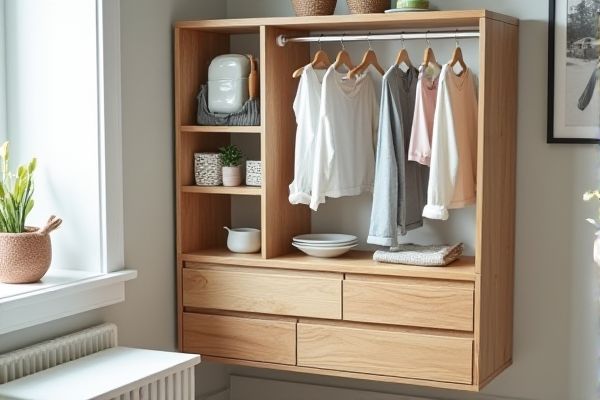
Hanging organizers maximize vertical space and are perfect for small rooms or closets, while drawer organizers offer compartmentalized storage that keeps items neatly separated and accessible. Discover which option best suits your storage needs and transforms your space by reading the rest of the article.
Table of Comparison
| Feature | Hanging Organizer | Drawer Organizer |
|---|---|---|
| Location | Hangs on walls, doors, or closets | Fits inside drawers |
| Space Utilization | Maximizes vertical space | Optimizes drawer compartments |
| Accessibility | Items visible and easy to reach | Items neatly separated but less visible |
| Installation | Requires hooks or rods | No installation, just placed inside |
| Ideal For | Shoes, accessories, small items | Utensils, office supplies, makeup |
| Portability | Easy to move and rearrange | Typically stationary |
| Durability | Varies by material; often fabric or plastic | Usually rigid plastic or wood |
Introduction to Organizers: Hanging vs Drawer
Hanging organizers maximize vertical space by attaching to doors or walls, ideal for small rooms and easy accessibility. Drawer organizers efficiently compartmentalize items within drawers, reducing clutter and improving item visibility. Choosing between hanging and drawer organizers depends on your space constraints and organizational needs for optimal storage solutions.
Key Differences Between Hanging and Drawer Organizers
Hanging organizers maximize vertical space by attaching to doors or walls, ideal for items you need quick access to, while drawer organizers efficiently compartmentalize belongings within confined drawer spaces for enhanced tidiness. The materials vary, with hanging organizers often made from fabric or mesh, promoting breathability, and drawer organizers commonly crafted from rigid plastic or wood to maintain shape and protect contents. Choosing the right organizer depends on your storage area and accessibility preferences, ensuring your belongings stay organized and easy to find.
Space Optimization: Which Organizer Saves More Room?
Hanging organizers maximize vertical space by utilizing unused wall or closet areas, making them ideal for small rooms or limited floor space. Drawer organizers optimize internal drawer layouts, reducing clutter and improving accessibility but do not free up external space. For maximizing overall room space, hanging organizers typically save more room by reclaiming vertical zones that would otherwise remain empty.
Accessibility and Convenience Comparison
Hanging organizers provide easy visibility and quick access to items by keeping them at eye level, reducing the need to rummage through drawers. Drawer organizers compartmentalize storage, maximizing space while maintaining a tidy appearance, but they may require bending or opening multiple drawers to find specific items. Both options enhance organization, yet hanging organizers excel in accessibility, while drawer organizers prioritize efficient space usage.
Material and Durability: What Lasts Longer?
Hanging organizers typically use fabric or mesh materials that offer flexibility and breathability but may wear out faster with frequent use. Drawer organizers are often made from solid materials like plastic, wood, or metal, providing greater durability and resistance to daily wear and tear. Choosing the right option depends on Your specific needs for longevity and the type of items you plan to store.
Aesthetic Appeal and Design Options
Hanging organizers offer a visually appealing, space-saving solution with various colors, patterns, and materials that enhance room decor while keeping items accessible. Drawer organizers provide a sleek, minimalist look by neatly compartmentalizing items within existing furniture, maintaining a clutter-free surface. Both options cater to different aesthetic preferences, with hanging organizers adding vertical interest and drawer organizers offering subtle, seamless integration.
Installation and Setup Overview
Hanging organizers require minimal installation, often featuring hooks or adhesive strips that allow for quick setup on closet rods or walls without tools. Drawer organizers typically need no installation, simply placed inside drawers to separate items, making them convenient for immediate use. Both options optimize storage space efficiently, but hanging organizers suit vertical spaces while drawer organizers enhance compartmentalization within existing drawers.
Ideal Uses: Where Each Organizer Works Best
Hanging organizers are ideal for maximizing vertical space in closets, entryways, or laundry rooms, providing easy access to shoes, accessories, and small clothing items. Drawer organizers work best inside dresser drawers or office desks to neatly separate and store smaller items like socks, underwear, utensils, or stationery, preventing clutter. Choosing between them depends on your storage needs and available space, ensuring Your belongings stay organized and accessible.
Maintenance and Cleaning Considerations
Hanging organizers typically require spot cleaning with a damp cloth and occasional dusting to maintain fabric integrity and prevent mildew, especially in humid environments. Drawer organizers, often made of plastic, wood, or metal, are generally easier to clean as they can be removed and washed or wiped down thoroughly. Both types benefit from regular cleaning to avoid dirt buildup, but drawer organizers tend to offer more convenient maintenance for long-term use.
Cost Effectiveness: Hanging Organizer vs Drawer Organizer
Hanging organizers typically offer greater cost effectiveness due to their lower material and manufacturing expenses compared to drawer organizers, which often require sturdier construction and more intricate designs. They maximize vertical space without the need for additional furniture, reducing overall investment in storage solutions. Drawer organizers, while sometimes pricier, provide superior compartmentalization and protection for delicate items, potentially reducing replacement costs over time.
 homyna.com
homyna.com